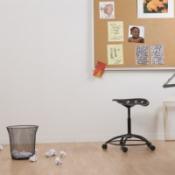Editor’s note: This article is the 15th in an A-Z series on issues related to creative blocks. This month we explore how openness to experience makes space for creativity.
Personality psychologists have identified five dimensions, referred to as the “Big Five,” to roughly describe human personality traits. These dimensions are extroversion, conscientiousness, openness to experience, agreeableness, and neuroticism. In particular, the openness to experience trait is associated with increased creativity and creative achievement. According to personality and creativity researchers, the sensation-seeking drive underlying people with this trait enables them to create more associations between stimuli, to be more self-reflective, and to have a higher interest in acquiring new experiences. As a result, these cognitive and behavioral processes are associated with higher levels of creativity.
So, how can artists and creative individuals use this personality dimension to their advantage in order to maximize creativity? How can being open to experience help one overcome creative blocks? And what if someone is naturally less inclined to exhibit this personality trait?
Though personality traits tend to be mostly stable throughout one’s lifespan—making it difficult to simply “become” more extroverted or conscientious, for example—our behaviors are more malleable with some focus and persistence. Even if you naturally have more conservative and rigid thinking patterns, you can develop and maintain certain openness-to-experience habits that can maximize potential for creative growth.
- Use your imagination: Even if it’s not something that comes up spontaneously for you, you may want to devote 10 to 20 minutes a day to letting your imagination to run wild. This might look something like playing fantasy-based games, brainstorming ideas for short stories, and having a no-filters approach to thinking about future possibilities.
- Expose yourself to other artists’ work: One of the characteristics of those who score high on the openness-to-experience measure is the involvement in aesthetically triggering experiences and the appreciation of artistic events. Accepting invitations to art galleries and plays or even going for a walk in nature may stimulate your perceptions and increase your aesthetic sensitivity.
- Switch your routine around: It may be comforting to follow a predictable schedule, commute, diet, and after-work routine, but it can limit your sense of receptiveness to new experiences. In order to benefit from the creativity that is correlated with this personality trait, you may want to incorporate an adventurous spirit in your day-to-day life. Adding variety in daily choices may help bring out the openness-to-experience side of your personality.
- Engage your intellect and cognitions: A thirst for knowledge and an interest in new information may come more naturally to some than to others. However, a conscious effort to read up on new ideas, pay attention to sensory experiences, learn a new language, and pick up new skills can stimulate the active process of openness to new experiences.
It’s not easy to change basic personality traits. Some might argue it is impossible. However, it is possible to implement behaviors consistent with some personality characteristics, such as openness to experience, especially when they are shown to predict higher creativity.
References:
- John, O. P. (1990). The “Big Five” factor taxonomy: Dimensions of personality in the natural language and in questionnaires. In L. Pervin (Ed.), Handbook of personality: Theory and research(pp. 66-100). New York, NY: Guilford Press.
- Kaufman, S. B. (2013, November 25). Openness to Experience and Creative Achievement. Scientific American. Retrieved from http://blogs.scientificamerican.com/beautiful-minds/openness-to-experience-and-creative-achievement/

The preceding article was solely written by the author named above. Any views and opinions expressed are not necessarily shared by GoodTherapy.org. Questions or concerns about the preceding article can be directed to the author or posted as a comment below.


 Creative Blocks from A to Z: Learned Helplessness
Creative Blocks from A to Z: Learned Helplessness Creative Blocks from A to Z: Motivation
Creative Blocks from A to Z: Motivation Creative Blocks from A to Z: Negative Thinking
Creative Blocks from A to Z: Negative Thinking

Please fill out all required fields to submit your message.
Invalid Email Address.
Please confirm that you are human.
Leave a Comment
By commenting you acknowledge acceptance of GoodTherapy.org's Terms and Conditions of Use.